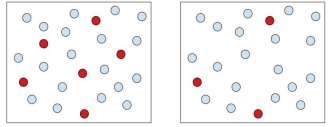Finding Weight Percent Given Solution in Grams
13.5: Solution Concentration- Mass Percent
-
- Last updated
- Save as PDF
- Page ID
- 47553
Learning Objectives
- Express the amount of solute in a solution in various concentration units.
To define a solution precisely, we need to state its concentration: how much solute is dissolved in a certain amount of solvent. Words such as dilute or concentrated are used to describe solutions that have a little or a lot of dissolved solute, respectively, but these are relative terms with meanings that depend on various factors.
Introduction
Concentration is the measure of how much of a given substance is mixed with another substance. Solutions are said to be either dilute or concentrated. When we say that vinegar is \(5\%\) acetic acid in water, we are giving the concentration. If we said the mixture was \(10\%\) acetic acid, this would be more concentrated than the vinegar solution.

A concentrated solution is one in which there is a large amount of solute in a given amount of solvent. A dilute solution is one in which there is a small amount of solute in a given amount of solvent. A dilute solution is a concentrated solution that has been, in essence, watered down. Think of the frozen juice containers you buy in the grocery store. To make juice, you have to mix the frozen juice concentrate from inside these containers with three or four times the container size full of water. Therefore, you are diluting the concentrated juice. In terms of solute and solvent, the concentrated solution has a lot of solute versus the dilute solution that would have a smaller amount of solute.
The terms "concentrated" and "dilute" provide qualitative methods of describing concentration. Although qualitative observations are necessary and have their place in every part of science, including chemistry, we have seen throughout our study of science that there is a definite need for quantitative measurements in science. This is particularly true in solution chemistry. In this section, we will explore some quantitative methods of expressing solution concentration.
Mass Percent
There are several ways of expressing the concentration of a solution by using a percentage. The mass/mass percent (% m/m) is defined as the mass of a solute divided by the mass of a solution times 100:
\[\mathrm{\% \:m/m = \dfrac{mass\: of\: solute}{mass\: of\: solution}\times100\%}\]
mass of solution = mass of solute + mass solvent
If you can measure the masses of the solute and the solution, determining the mass/mass percent is easy. Each mass must be expressed in the same units to determine the proper concentration.
Suppose that a solution was prepared by dissolving \(25.0 \: \text{g}\) of sugar into \(100.0 \: \text{g}\) of water.
The mass of the solution is
mass of solution = 25.0g sugar + 100.0g water = 125.0 g
The percent by mass would be calculated by:
\[\text{Percent by mass} = \frac{25.0 \: \text{g sugar}}{125.0 \: \text{g solution}} \times 100\% = 20.0\% \: \text{sugar}\]
Example \(\PageIndex{1}\)
A saline solution with a mass of 355 g has 36.5 g of NaCl dissolved in it. What is the mass/mass percent concentration of the solution?
Solution
We can substitute the quantities given in the equation for mass/mass percent:
\(\mathrm{\%\: m/m=\dfrac{36.5\: g}{355\: g}\times100\%=10.3\%}\)
Exercise \(\PageIndex{1}\)
A dextrose (also called D-glucose, C6H12O6) solution with a mass of 2.00 × 102 g has 15.8 g of dextrose dissolved in it. What is the mass/mass percent concentration of the solution?
- Answer
-
7.90 %
Using Mass Percent in Calculations
Sometimes you may want to make up a particular mass of solution of a given percent by mass and need to calculate what mass of the solute to use. Using mass percent as a conversion can be useful in this type of problem. The mass percent can be expressed as a conversion factor in the form \(\frac{g \; \rm{solute}}{100 \; \rm{g solution}}\) or \(\frac{100 \; \rm g solution}{g\; \rm{solute}}\)
For example, if you need to make \(3000.0 \: \text{g}\) of a \(5.00\%\) solution of sodium chloride, the mass of solute needs to be determined.
Solution
Given: 3000.0 g NaCl solution
5.00% NaCl solution
Find: mass of solute = ? g NaCl
Other known quantities: 5.00 g NaCl is to 100 g solution
The appropriate conversion factor (based on the given mass percent) can be used follows:
To solve for the mass of NaCl, the given mass of solution is multiplied by the conversion factor.
\[g NaCl = 3,000.0 \cancel{g \: NaCl \:solution} \times \frac{5.00 \:g \: NaCl}{100\cancel{g \: NaCl \: solution}} = 150.0g \: NaCl\]
You would need to weigh out \(150 \: \text{g}\) of \(\ce{NaCl}\) and add it to \(2850 \: \text{g}\) of water. Notice that it was necessary to subtract the mass of the \(\ce{NaCl}\) \(\left( 150 \: \text{g} \right)\) from the mass of solution \(\left( 3000 \: \text{g} \right)\) to calculate the mass of the water that would need to be added.
Exercise \(\PageIndex{1}\)
What is the amount (in g) of hydrogen peroxide (H 2 O 2 ) needed to make a 6.00 kg, 3.00 % (by mass) H 2 O 2 solution?
Answer
180 g H 2 O 2
Finding Weight Percent Given Solution in Grams
Source: https://chem.libretexts.org/Bookshelves/Introductory_Chemistry/Map%3A_Introductory_Chemistry_(Tro)/13%3A_Solutions/13.05%3A_Solution_Concentration-_Mass_Percent